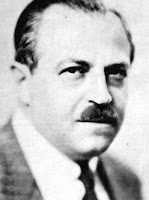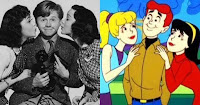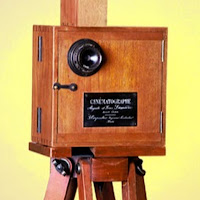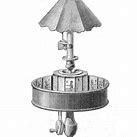Gingerbread man like in form. The character of Gumby was born. Gumby first appeared in a series of shorts on Howdy Doody starting in 1955. He became popular over the following decades, and he was eventually given his own series, The Adventures of Gumby, which ran from 1957 throughout the 1960s. Here is a brief timeline of the highlights.
Vintage Cartoons and Cartoon History From 20's 40's 50's 60's 70's 80's....And Beyond
Sunday, January 30, 2022
Do You Remember Gumby? A Little History Of The Green Clay Boy With A Different Spend On Animation
Gingerbread man like in form. The character of Gumby was born. Gumby first appeared in a series of shorts on Howdy Doody starting in 1955. He became popular over the following decades, and he was eventually given his own series, The Adventures of Gumby, which ran from 1957 throughout the 1960s. Here is a brief timeline of the highlights.
Saturday, January 29, 2022
Why Some Animated Cartoons Were Banned From History
There are many reasons why animated cartoons are banned. The first reason is that they are seen as racist by some people. Another reason for them being banned is that they are seen as offensive. Some people find them offensive because of the way they portray certain races of people. They also make fun of people who speak in an accent or have a funny voice. This is a good reason to ban them because it makes people feel uncomfortable.
Another reason for cartoon characters being banned is because they are seen as sexual. Some cartoons are very sexual, and this is a good reason for them to be banned. They may show something that is inappropriate for children to see.
Another reason for cartoons to be banned is because they are seen to be violent. Some cartoons are very violent and this is another reason for them to be banned. This is especially true if the cartoon is violent against a certain race or religion.
Another reason for these cartoons to be banned is because of the way they portray different races. They can be offensive because of the way they show some people as being stupid and lazy and of course that is not true at all. Any way these are the top few reasons that cartoons were banned from history, but you can still see some of these online on YouTube. I have one below this post you can view : Try not to be offended just showing a little history lesson. BJ / 🙈🙉🙊
Friday, January 28, 2022
Charlie Chaplin Cartoons "Makes Cartoon History"
Pat Sullivan, the head of the Sullivan Studios, contacted Chaplin in the spring of 1917. He wanted Chaplin to be a part of an animated cartoon starring him. Chaplin was cooperative and supplied a group of photographs of himself to be used as the models for the artwork. Otto Messmer, the head animator at the Sullivan Studios, was a huge fan of Chaplin and the project was started.
 Then a couple of delays happened, World War 1-Messmer was drafted, and Prison time- for Sullivan. The Sullivan Studio came to a complete halt (Closed ). Sullivan Studios reopened 9 months later, and the work on the project restarted. Then the project is further developed and has bigger focus than before. Eventually, the work is finished. And then the animated Charlie Chaplin cartoons are released.
Then a couple of delays happened, World War 1-Messmer was drafted, and Prison time- for Sullivan. The Sullivan Studio came to a complete halt (Closed ). Sullivan Studios reopened 9 months later, and the work on the project restarted. Then the project is further developed and has bigger focus than before. Eventually, the work is finished. And then the animated Charlie Chaplin cartoons are released.Sullivan was a longtime collaborator with Chaplin, and it was during this time that he produced his last and most successful series of cartoons. The series was a continuation of the war saga of the first series and was eventually released. It was only released after Chaplin had returned to the states after the war and it concluded in October 1919.
Charlie Chaplin was a master of silent films. It is his ability to bring his audiences on the verge of laughter with his masterful art that made him an icon. The unique thing about Chaplin’s silent films and cartoons they continued, even after sound films started to appear. They also are a reflection of Chaplin’s success at that time. Charlie Chaplin animated cartoons were a success for a long time running. I don't know about you, but I still enjoy them today. Got one below this post. BJ / 🙈🙉🙊
Wednesday, January 26, 2022
Van Beuren Studios: Powerful Animated Studio For A Short Time 1928-1936
 Amadee Van Beuren (pronounced Van Burr-en) bought Fables Studio and renamed it Van Beuren studios in 1928. During the Golden Age Of Animation his studio was the least known, yet it packed a serious punch. Van Beuren was a business grad and a great businessman which this post is about. If asked what Van Beuren Studios was famous for, most people today would probably look at you with a blank stare, not knowing that the little-known production company also helped lead the pack when it came to classic cartoons of their time. Van Beuren Studios was located across the street from Fleischer Studios, one of his biggest competitors of that time. Like many non-Disney/Warner Bros. cartoon studios, critics and historians generally tend to give Van Beuren the footnote treatment, writing off the cartoons as cheaply produced drivel—but this isn't quite true. He put together some great shorts (Cartoons) that made great headway during the time. He also hired a few animators from competitors that also made a difference at the studio, giving them some free will. The studio produced cartoons featuring Felix the Cat as part of its Rainbow Parade series: The Goose That Laid the Golden Egg, Neptune Nonsense, and Bold King Cole, all released in 1936. Van Beuren released his films through RKO Pictures. In 1932, Van Beuren purchased Charlie Chaplin's 12 Mutual Film Company comedies for $10,000 each and re-released them through RKO Radio Pictures. Chaplin, not owning the rights to his Mutual Films, had no legal recourse against Van Beuren or RKO. Here is a list of production work that Van Beuren Studios produced during their brief 1928 - 1936 history.
Amadee Van Beuren (pronounced Van Burr-en) bought Fables Studio and renamed it Van Beuren studios in 1928. During the Golden Age Of Animation his studio was the least known, yet it packed a serious punch. Van Beuren was a business grad and a great businessman which this post is about. If asked what Van Beuren Studios was famous for, most people today would probably look at you with a blank stare, not knowing that the little-known production company also helped lead the pack when it came to classic cartoons of their time. Van Beuren Studios was located across the street from Fleischer Studios, one of his biggest competitors of that time. Like many non-Disney/Warner Bros. cartoon studios, critics and historians generally tend to give Van Beuren the footnote treatment, writing off the cartoons as cheaply produced drivel—but this isn't quite true. He put together some great shorts (Cartoons) that made great headway during the time. He also hired a few animators from competitors that also made a difference at the studio, giving them some free will. The studio produced cartoons featuring Felix the Cat as part of its Rainbow Parade series: The Goose That Laid the Golden Egg, Neptune Nonsense, and Bold King Cole, all released in 1936. Van Beuren released his films through RKO Pictures. In 1932, Van Beuren purchased Charlie Chaplin's 12 Mutual Film Company comedies for $10,000 each and re-released them through RKO Radio Pictures. Chaplin, not owning the rights to his Mutual Films, had no legal recourse against Van Beuren or RKO. Here is a list of production work that Van Beuren Studios produced during their brief 1928 - 1936 history.- Aesop's Fables
- Cubby Bear
- Amos 'n' Andy
- The Little King
- Rainbow Parade (color series)
- Felix the Cat
- Molly Moo-Cow
- Burt Gillett's Toddle Tales
- Tom and Jerry
- Toonerville Trolley
- Parrotville
Live-action:
- James the Cat
- Stung (1931)
- Bring 'Em Back Alive (1932)
- Adventure Girl (1934)
- Wild Cargo (1934)
- Fang and Claw (1935 )
Saturday, January 15, 2022
10 Nosey Things You Might Want To Know About The Legendary "Walt Disney"
In this blog post about Walt Disney history facts: There is no specific timeline of events, just random history moments that you might not have read or heard about "Walt".
1. During World War 1, Walt drew patriotic cartoons for his high school newspaper.
2. At 17 Walt wanted to run away with his best male friend to join the Red Cross. Parents found out, and that ended that.
3. Walt was court-martial by the Red Cross, yes, he finally got to join up. The whole story on this topic: Tap side bar picture of Walt Disney.
4. Walt got real sick with influenza in his teens but recovered.
5. Walt altered his birthdate on his passport application from 1901 to 1900 so he could serve his country.
6. Walt worked at the local post office in his hometown in Marceline, Missouri.
7. Walt's real family last name was D'Isigny which the family changed many years later to Disney.
8. Walt got paid $40 dollars per wk as a cartoon animator, that's like $500 per wk today (Big Bucks) for just starting out as a young working man.
9. Walt wanted to name Mickey Mouse, Mortimer but his wife persuaded him not to and said call him Mickey. Thank you, Mrs. Disney!
10. Walt did not allow woman to become animators early on. An infamous letter from Mary Ford might have changed all that. Retta Scott got hired in 1942 as the first woman animator for Disney. See (Pic) of her on side bar of this blog for more info about her.
Well of course there is more nosey history facts about Walt and maybe I will update this blog post later.
BJ/ 🙈🙉🙊
Tuesday, January 11, 2022
Cartoon History Funny: How The Earth Will End
 Alfred Weiss / Head of Inkwell Studios, Weiss began releasing sound cartoons in 1929, with soundtracks recorded at Metropolitan Studios. Some were reissues of silent Inkwell cartoons with newly added soundtracks.
Alfred Weiss / Head of Inkwell Studios, Weiss began releasing sound cartoons in 1929, with soundtracks recorded at Metropolitan Studios. Some were reissues of silent Inkwell cartoons with newly added soundtracks. Max Fleischer / The silent KoKo films were extensions of the first animated films in which live action artists would bring drawings to life, implementing another of Fleischer's inventions, the Rotograph. The Rotograph was a system for combing live action and animation.
Max Fleischer / The silent KoKo films were extensions of the first animated films in which live action artists would bring drawings to life, implementing another of Fleischer's inventions, the Rotograph. The Rotograph was a system for combing live action and animation.The Fleischer Brothers went on to produce many memorable characters utilizing other techniques they invented, including Betty Boop and Popeye.
Thursday, January 6, 2022
Real Humans Inspired Some Cartoon Characters
 Well, let's take a look at some cartoon history facts to find out. Do you remember "Yosemite Sam" cartoon? and Red Skelton, actor/comedian that had his own television show from 1951-1971 who always ended his show with the words " God Bless". In one of his movies, he played Sheriff Deadeye who inspired Yosemite Sam. Can you tell the resemblance? The eyebrows and the mustache, you need to see the clip from YouTube...
Well, let's take a look at some cartoon history facts to find out. Do you remember "Yosemite Sam" cartoon? and Red Skelton, actor/comedian that had his own television show from 1951-1971 who always ended his show with the words " God Bless". In one of his movies, he played Sheriff Deadeye who inspired Yosemite Sam. Can you tell the resemblance? The eyebrows and the mustache, you need to see the clip from YouTube... Disney's Tinker Bell was just a sweet little fairy (1953) that I would envision being the tooth fairy putting money under my pillow after I lost a tooth, of course it was my mom that put the money there, 😏 I was a little boy. "I can't help it; I was Disney mesmerize as a kid". Anyway, Margaret Kerry was a model/actress that the inspiration for Tinker Bell came about for Disney's animated movie Peter Pan. Kerry was behind the movements of the animated character for the movie that most people my age (69) and younger remembered and loved. Didn't you love Tinker as a Kid? I know I did, and I was a small boy. Lol
Disney's Tinker Bell was just a sweet little fairy (1953) that I would envision being the tooth fairy putting money under my pillow after I lost a tooth, of course it was my mom that put the money there, 😏 I was a little boy. "I can't help it; I was Disney mesmerize as a kid". Anyway, Margaret Kerry was a model/actress that the inspiration for Tinker Bell came about for Disney's animated movie Peter Pan. Kerry was behind the movements of the animated character for the movie that most people my age (69) and younger remembered and loved. Didn't you love Tinker as a Kid? I know I did, and I was a small boy. Lol"Popeye" the sailor man was base off a real person by the name of Frank Fiegel. The creator of Popeye knew a man in Chester, Illinois who he based his cartoon character after. He smoked a pipe and was somewhat of brawler. I did a full blog post on Mr. Fiegel on this website and its pretty interesting story. Just go to the older post tab and check it out. / BJ 🙈🙉🙊
Monday, January 3, 2022
Thomas Edison Invention Helped Animation Cartoon Development History
You probably remember him as the famous inventor who invented the Light bulb💡 Edison was an American inventor and businessman and developed many devices that influenced everyone in the world. The devices invented include the phonograph, the camera and the kinetoscope. The Kinetoscope is one of the first cinematographic devices, created in (1894). It was designed to allow one person at a time to watch movies through a peephole at the top of the device. The Kinetoscope was not a movie projector; however, it was touted as the basic approach that would eventually become the main product for all film screenings before the invention of video. It created the illusion of movement by placing a perforated film strip with sequential images on a light source with a high-speed shutter.
But earlier before all this great development with cinematography 1n 1877 a man named Charles Reynaud a French inventor was responsible for the first projected animated cartoons. Reynaud created the Praxinoscope in 1877 and then, on 28 October 1892 he projected the first animated film in public in Paris.
In my conclusion with this post, in my research it was a bit confusing who invented the cinematography first but there was a lot of competition amongst these great minds of inventors, and they all contributed to the great age of animation. / BJ🙈🙉🙊













